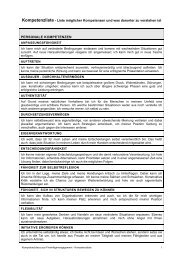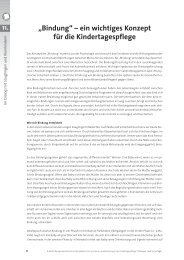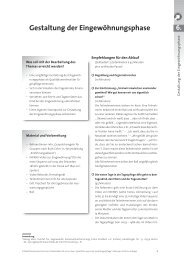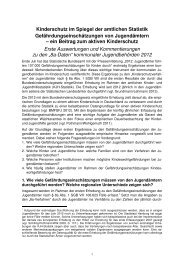Prevention of Right-Wing Extremism, Xenophobia and Racism in ...
Prevention of Right-Wing Extremism, Xenophobia and Racism in ...
Prevention of Right-Wing Extremism, Xenophobia and Racism in ...
You also want an ePaper? Increase the reach of your titles
YUMPU automatically turns print PDFs into web optimized ePapers that Google loves.
YNGVE CARLSSON<br />
Violent <strong>Right</strong>-<strong>W<strong>in</strong>g</strong> <strong>Extremism</strong> <strong>in</strong> Norway: Community Based <strong>Prevention</strong><br />
<strong>and</strong> Intervention<br />
This article presents strategies <strong>and</strong> measures for prevent<strong>in</strong>g violent right-w<strong>in</strong>g extremism <strong>in</strong><br />
Norway 4 . The purpose <strong>of</strong> such a presentation is to <strong>in</strong>spire <strong>and</strong> make suggestions as to how<br />
this specifi c problem may be met. It is then up to the readers to fi nd out whether they they can<br />
<strong>in</strong> clude them <strong>in</strong> their problem-solv<strong>in</strong>g repertoire <strong>in</strong> their respective contexts. One cannot <strong>and</strong><br />
shall not uncritically transfer problem-solv<strong>in</strong>g strategies from one context to another. I will<br />
therefore beg<strong>in</strong> by emphasis<strong>in</strong>g the situation <strong>in</strong> Norway regard<strong>in</strong>g violent right-w<strong>in</strong>g extrem-<br />
ism. The guid<strong>in</strong>g questions here are: what k<strong>in</strong>d <strong>of</strong> problems are the described strategies an<br />
answer to? And, under which which societal conditions both the problem <strong>and</strong> the problem-solv<strong>in</strong>g<br />
strategies have have been developed? I will then present some key strategies <strong>and</strong> measures to deal<br />
with such problems. In the end I will discuss their results <strong>and</strong> limitations.<br />
This article focuses on <strong>in</strong>tervention, especially when the problem with violent extreme<br />
groups is limited <strong>and</strong> potentially potentially manageable. There are two reasons for this:<br />
First, one important experience <strong>in</strong> Norway has been that local communities have been<br />
shocked, confused <strong>and</strong> uncerta<strong>in</strong> as to how to respond when confronted with aggressive <strong>and</strong><br />
violent right-w<strong>in</strong>g extremism. This has revealed a need for a toolbox <strong>of</strong> <strong>in</strong>tervention strategies<br />
<strong>and</strong> methods.<br />
Second, it would be a very complex task to present the full range <strong>of</strong> a nation’s strategies <strong>of</strong><br />
prevent<strong>in</strong>g racism, <strong>in</strong>tolerance, undemocratic values, aggressiveness <strong>and</strong> violence – even if<br />
this nation is a small one. Most <strong>of</strong> the work to prevent whatever is defi ned as a problem (bad<br />
health, drug-abuse, behaviour-problems, racism etc.) is done through k<strong>in</strong>dergartens, schools,<br />
the health-service, the child-care system <strong>and</strong> youth work units <strong>in</strong> 432 Norwegian municipali-<br />
ties. Because local municipalities enjoy great freedom as to how to organise their preventive<br />
work <strong>and</strong> can thus decide which methods <strong>and</strong> measures to use, preventive work cannot be de-<br />
scribed through nation-wide programs. Moreover, preventive work is <strong>of</strong>ten hidden <strong>in</strong> the daily<br />
activities <strong>of</strong> public <strong>in</strong>stitutions, <strong>and</strong> there is probably a wide variety <strong>of</strong> ways to prevent the<br />
k<strong>in</strong>d <strong>of</strong> problems discussed <strong>in</strong> this article. It is reasonable to assert that nobody has access to<br />
comprehensive <strong>and</strong> <strong>in</strong> depth <strong>in</strong>formation as to what is be<strong>in</strong>g done <strong>in</strong> this fi eld <strong>in</strong> Norway. It is<br />
also reasonable to believe not only that good preventive work is carried out by municipal units<br />
(schools, youth youth clubs etc.), NGOs like political parties <strong>and</strong> their youth organisations, antianti- racist organisations, sport clubs, <strong>and</strong> religious organisations etc., but also that some <strong>of</strong> this<br />
work will be superfi cial <strong>and</strong> even counterproductive.<br />
It is easier to provide an overview <strong>of</strong> <strong>in</strong>tervention strategies <strong>and</strong> measures when an extreme<br />
<strong>and</strong> violent group is about to develop. One reason for this is that <strong>in</strong>terventions <strong>in</strong> those Nor- Nor-<br />
4 Thanks to Pr<strong>of</strong>essor Tore Bjørgo at the Norwegian Police University College for valuable comments <strong>and</strong><br />
contributions to this article.<br />
12 Violent <strong>Right</strong>-<strong>W<strong>in</strong>g</strong> <strong>Extremism</strong> <strong>in</strong> Norway

















